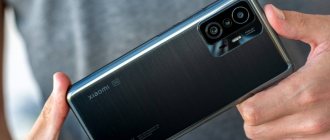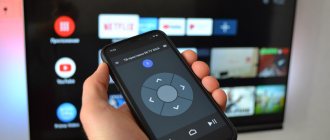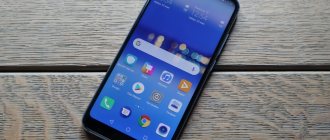The first (and so far only) smartphone of the new sub-brand of the Chinese giant Xiaomi has gone on sale. The manufacturer emphasizes that the Pocophone F1, for only $300, has flagship characteristics and is no worse than top models that are 2-3 times more expensive. Is it really? And in general, what to expect from the new product?
The best Telegram channel about technology (possibly)
Why did the “great and terrible” Xiaomi, whose products are objectively successful and popular, need to reinvent the Pocophone wheel? If you are not too familiar with the history of the Chinese company, then... In short, the inhabitants of the Middle Kingdom have a completely different perception of patent law from the Western world. Therefore, it was decided to begin a full-fledged conquest of Europe, India and the USA with the help of a subsidiary global brand. In addition, the original Mi and Redmi have a very confusing model line: it will be difficult for the uninitiated to understand the nuances of the classification. So Poco F1 is a great way to start with a clean slate.
Specifications
- Model: M1805E10A
- Screen: 6.18”, IPS LCD, 18.5:9, 2246 x 1080 pixels, 416 PPI, 440 DPI
- Operating system: Android 8.1 in MIUI Global 9.6 shell
- Processor: Qualcomm Snapdragon 845, 8 cores Max 2.8 GHz (4x Kryo 385 Silver @ 1766 MHz + 4x Kryo 385 Gold @ 2803 MHz), 10nm process technology
- GPU: Adreno 630 (710 MHz)
- RAM: 6 GB
- Built-in memory: 128 GB + MicroSD up to 256 GB
- Main camera: 12 MP (f/1.9) + 5 MP, LED flash, macro photography, 4K video recording
- Front camera: 20 MP (f/2.0) with SuperPixel technology
- Slots: hybrid tray – 2 nano-SIM / nano-SIM + microSD
- Communication: FDD-LTE: band 1/3/5/7/8/20; TDD-LTE: band 38/40/41, HSDPA 800/850/900/1800/2100/2300 Mbit/s, GSM 850/900/1800/1900, Wi-Fi 802.11ac, Wi-Fi Direct, Bluetooth 5.0, USB, A-GPS, GPS, GLONASS, BeiDou
- Sensors: Accelerometer, Linear Accelerometer, Game Rotation Vector, Geomagnetic Rotation Vector, Rotation Vector, Gravity Sensor, Gyroscope, Uncalibrated Gyroscope, Light Sensor, Magnetometer, Uncalibrated Magnetometer, Orientation Sensor, Proximity Sensor, Fingerprint Sensor, Compass, Step Detector, pedometer, Hall sensor
- NFC: no
- Audio: MP3, AAC, WAV, WMA
- Connectors: Mini-Jack 3.5 mm, USB Type-C 2.0
- Battery: 4000 mAh (lithium polymer), non-removable, Qualcomm Quick Charge 4.0 fast charging
- Dimensions: 75.2 x 155.5 x 8.8 mm
- Weight: 187 g
- Available colors: grey, red, blue
- Case material: metal + plastic
- Package contents: smartphone, charger, USB cable, quick start guide, card eject tool, case
- Price (at the time of publication of the review): from 20,990 rubles
Video
Video recording with resolution up to 4K is supported. The speed is limited to 30 fps. With 1080p resolution, the speed is also a maximum of 30 fps.
Video bitrate is 42 Mbps, 20 Mbps with 1080p resolution, stereo audio 192 Kbps. These numbers are for the H.264 codec, although you can upgrade to the more efficient H.265.
The video has fairly high clarity, detail and excellent contrast. The colors are rich, but not overly so. The dynamic range is impressive, just like in photographs.
Electronic image stabilization should seem to work at all resolutions, but judging by the shaking in 4K format, it is not activated in it. 1080p video is very smooth.
Equipment
The Pocophone F1 is packaged in a small cardboard box with a laconic design: a black cover with a bright yellow name of the device. There are no drawings, embossing or other “decorations” - the main emphasis is on contrasting color combinations. Global Version is highlighted in red on the side - the first device of the new brand is ready to conquer the world.
The bottom of the box is also yellow. Inside there is a folder with a user guide and a silicone case, under it is the device itself, below is an adapter and a wire in special recesses. Only after removing the latter can you notice a paperclip attached to a special holder for removing the tray. No headset included.
Set
The box from under the device looks more stylish than the device itself. Thick cardboard, neat, minimalistic printing, bright and contrasting colors - everything was done as it should.
Inside we have a standard pack of accessories:
- charging at 5 - 12 volts and 1.5 - 2.5 amperes with support for QS 3.0
- USB C cable
- needle for SIM card tray
The manufacturer did not forget about the case. True, it is thin, silicone and will turn yellow within a month. It will do for the first time, but later you will have to get something more serious.
Appearance
The Pocophone F1 is not distinguished by any special design delights, and this is expected: it is better for the manufacturer to save on the shell than on anything more significant. Visually, the device gives the impression of being somewhat “robust”: a phablet-sized screen, a thick body with rounded corners (and Poco’s shape is softer than that of top-end Xiaomi devices). Despite the fact that only plastic was used in the finishing of the case, the smartphone weighs no less than its metal counterparts.
In the hand, a smartphone with a diagonal of just over 6 inches and a slightly atypical aspect ratio of 18.5 to 9 fits well. Of course, it is too big for a small female hand, but if you use gesture controls rather than on-screen keys, you don’t feel much discomfort. Taking pictures is more comfortable using the fingerprint sensor on the rear panel.
The back cover is made of simple matte polycarbonate in a modest gray color. To tell the truth, this shade can be called the standard of inconspicuousness: our Pocophone F1 is gray, like the everyday life of an Omsk plumber. If the “perishable” color scheme categorically does not appeal to you, you can choose more cheerful ones - red or blue. In addition, the manufacturer promised to release replacement rear panels for about $5. For example, in India, 4 options have already begun to be sold: leather, wood, camouflage and matte graphite. They do not particularly protect the smartphone, covering only the back surface of the device, but they allow you to add visual variety.
The “meaning center” of the back cover is a shiny metal block: a dual camera sensor and a fingerprint sensor below. On the right is a dual LED flash. It would seem like a small thing, but the red edging of the lenses adds an elegant color accent that dilutes the inconspicuous design of the back. The convex oblong element looks very stylish, but this configuration has an obvious “jamb”: the glossy surface quickly becomes stained with fingerprints. Moreover, the finger often first hits above the fingerprint sensor - on the camera. Lenses have to be wiped frequently.
At the bottom of the back panel the silver Pocophone logo shines, and just below in small print there is information about the manufacturer.
The design of the front panel is reminiscent of the same iPhone X and a crowd of epigones, except that the unibrow here is especially monumental. (Probably, the creators of the Pocophone F1 were directly inspired by the main icon of the unibrow - Frida Kahlo.) It houses an infrared camera (IR Face Unlock), a speaker, a front-facing camera and various sensors.
Under the display, whose corners have been rounded even more at the bottom, there remains a fairly wide strip of free space. There is no physical button, but there is a monochrome light indicator located right in the center. The screen frames are also quite thick, but this is not annoying.
In the center of the bottom end there is a Type-C connector, with identical grilles to the right and left of it. A speaker is hidden under one, and a conversational microphone is hidden under the other. The headphone jack was moved to the top edge. An additional microphone is also installed there. The keys are also trivial: on the right side there is a volume rocker and a Power button, on the left there is a hybrid tray for SIM and microSD.
There are no questions about the build quality: nothing plays, creaks or dangles. The smartphone looks modest and inconspicuous. The side edges of the case are made of painted plastic, so any fall will instantly tear off the coating.
This is why you should immediately put the supplied silicone case on your smartphone. By the way, its glossy black surface makes the appearance of the device much more elegant.
⇡#Autonomous work
Another important advantage of the Xiaomi Pocophone F1 is its capacious battery. There is a battery with a capacity of 15.2 Wh (4000 mAh, 3.8 V), which, although it does not turn the smartphone into a long-liver like the Nokia 3310, and does not give any superpowers at all, but allows you to use it quite calmly gadget all day and not think about charging. It is imperative to charge the Pocophone F1 overnight: do not expect to spend a day and a half to two days with it without recharging - unless you hardly touch the smartphone in everyday life.
In our traditional test with HD video playback at maximum brightness, with the wireless connection turned on, with active updates, the Pocophone F1 lasted a little over eight hours - for a smartphone with an LCD screen, this is a very respectable indicator.
Pocophone F1 supports fast charging using the Quick Charge 3.0 standard. Using the included charger, its battery is filled to 100% in 1 hour 50 minutes.
Screen
The Pocophone F1 IPS display has an impressive 6.18” diagonal with a not quite typical aspect ratio of 18.5:9, that is, Full HD+.
Visually, there are no particular complaints about the screen - the picture is juicy, bright, contrasty, there is no pixelation, and colors are not distorted when rotated. The only thing is that the brightness in sunny weather is still a little lacking.
The settings menu provides the user with the widest range of tools for individually adjusting image parameters. Here you can not only select a gentle mode for reading and, if necessary, a schedule for turning it on and off, but also manually determine the desired display shade, as well as set the brightness and hue in night mode. Beauty!
The display recognizes 10 simultaneous touches. There are no complaints about sensitivity, it recognizes control gestures without problems.
Purely visually, some may be annoyed by the monumental unibrow, but it can be easily removed by covering it with a black stripe - the corresponding item can be found in the settings menu. But the oleophobic coating is a bit of a let down: the phone gets dirty with fingerprints pretty quickly.
Display
The POCO F1 screen has a diagonal of 6.18 inches, which is equal to 15.70 cm. The display is based on an IPS matrix covering 100% of the sRGB spectrum, with FHD+ resolution (1080 x 2246 pixels) and a pixel density of 416 PPI. Thanks to this, the picture is quite clear and uniform. The screen refresh rate is 60 Hz, which saves battery power on your smartphone.
The maximum screen brightness reaches 455 nits, which is enough for comfortable reading of information from the display even in direct sunlight. Moreover, the protective glass of the display has an anti-reflective coating. To protect the matrix, Corning Gorilla Glass 3 is used, which can withstand drops from a meter height.
| Screen resolution | 1080 x 2246 pixels |
| Diagonal | 6.18″ (15.70 cm) |
| Type | IPS LCD |
| Aspect Ratio | 18:9 |
| Pixel Density | 416 dots per inch (ppi) |
| Update frequency | 60 Hz |
| Maximum brightness | 455 nits |
| Screen protection | Corning Gorilla Glass 3 |
| Screen to body ratio | 82,13% |
| Color rendition | 16 million colors |
| Frameless screen | Yes |
| HDR support | No |
Iron
What they really didn’t skimp on was hardware. So far, the F1 is the most affordable smartphone with the latest Qualcomm Snapdragon 845, created using 10 nm technology. According to official data, the 8-core processor accelerates to 2800 MHz: 4 Kryo 385 Silver cores reach 1766 MHz, and 4 more Kryo 385 Gold cores reach 2803 MHz.
In addition, at the presentation of the smartphone, representatives of Xiaomi enthusiastically talked about the benefits of the unique liquid cooling system, which should protect the device from overheating and related problems. During long gaming sessions, the Pocophone still inevitably heats up, although it doesn’t really boil to the point of shutting down completely.
But you and I understand that the beautiful words of marketers and real life are not the same thing. In fact, the main secret ingredient of the miracle cooling is reduced maximum processor power. And, judging by the CPU Throttling Test and my own observations, the phone still lags.
Nevertheless, heavy games run quite quickly: even the reduced capabilities of the Snapdragon 845 are more than enough, and the latest Adreno 630 (710 MHz) graphics chip does its best. You can safely play at 60 FPS (the maximum value that was achieved during tests was 175 FPS).
The results of Antutu and other authoritative benchmarks are on par - the results are decent. 6 GB of RAM makes this smartphone nimble in everyday tasks, such as Internet surfing, working with documents and images. If you are not a rabid fan of gaming who spends hours in some “Tanks” or PUBG, then the contents of the test subject will definitely please.
The storage on our model is designed for 128 GB - and this is quite “fat”. Plus you can install MicroSD up to 256 GB.
Like any self-respecting flagship, Pocophone is equipped with a fairly fast fingerprint sensor, which is installed on the rear panel without any frills. It works immediately - no complaints. The main thing is to keep your hands dry. In addition, the sensor is convenient to use as an additional button for taking photographs.
The most convenient way to unlock (especially in the cold season) is the Face Unlock function. This initially flagship feature gradually became available for budget devices. But on most models, this unlocking is only available in good lighting. The creators of Pocophone radically solved the problem by installing an infrared camera in the monobrow. And... lo and behold! Unlocking works even in complete darkness. Now, on winter evenings, the F1 owner will not have to take his hands out of warm gloves once again. The only thing is that you need to hold the phone strictly vertically: in a horizontal position the camera does not work. And one more small nuance. For now, Face Unlock is only available if you specify Hong Kong or India as your region in the settings. In Russia they are still waiting for firmware updates.
Essentially, the Poco F1 gets the best bang for its buck. It would be foolish to expect that Xiaomi will make this smartphone cooler than the same flagship Mi8 for $400. Do you want 4 hundred quality? Pay extra.
Performance
As we noted above, Qualcomm Snapdragon 845 is the most powerful chipset to date. The results of synthetic tests, screenshots of which are presented in this section, fully confirm this.
There is absolutely no need to write a lot of words about the performance of the Pocophone F1 - suffice it to say that it is among the ten most productive devices on the market. The smartphone copes with any tasks assigned to it, and does it much faster than any competitor. This applies to launching applications, displaying web pages, switching between tasks and absolutely any action you will perform. The difference with smartphones on other chipsets is visible to the naked eye, and it is impressive.
Gaming lovers should love the Pocophone F1 with all their hearts. In the 3D Mark test, it scored 4,159 points, which is the best result among 98% of other devices. This smartphone handles any game even at maximum graphics settings, without showing significant heating of the case or processor. There is no other gadget on the market today that has similar gaming characteristics at such a price.
System and software
The Pocophone F1 launcher, created on the basis of MIUI 9 and Android 8.1, has become one of the main features of the first device of the international brand. And yet, yes, at first glance, this shell is quite different from the traditional Xiaomi interface: it seems closer to “naked” Android. The design style of icons and menus is much more laconic and modest; there are no traditional animations.
If in the original firmware all the icons are displayed on the main screen, then in the launcher a kind of “Start” menu has been allocated - by swiping from bottom to top, the full set of programs is displayed. On the desktop there will be only the main icons and folders installed by the manufacturer. Moreover, the set will vary depending on the selected region.
Desktop of the Russia region (gesture control):
Any program you install will fall into this general “corral,” which is not always convenient: the question immediately arises of where to look for the application. In order not to get confused, you can rummage through the settings and display all the new items on the main screen, or you can learn to navigate the “hodgepodge”. Fortunately, there you can configure sorting by thematic categories or even by icon color.
Hong Kong region desktop (with on-screen keys):
On the desktop is the traditional set that Xiaomi installs on its flagships. In addition to the set from Google, Facebook and Microsoft, there is a full set of its own services, such as a browser, file manager, and so on. A special place in this “pantheon” is occupied by applications for Mi account holders. In general, it’s not very comfortable to use the system without registering it: you can’t even change the desktop theme! It’s clear that Xiaomi, like many other manufacturers, strive in every possible way to strengthen the “connection” of their users with the brand: register, chat in the chat, use club “goodies”, get a discount on a new smartphone from Xiaomi, transfer data between devices of one without any problems manufacturer... In short, welcome to the cozy “sect”.
In the settings, everything is decorous and noble: a single style, discreet design of menu items without highlighting them in different colors. Is this practically the original Android 8.1? But as soon as you see “About phone” as the first item, you immediately understand that this is still the same MIUI, except perhaps a little “combed.” There are all the same additional firmware features from Xiaomi, such as all sorts of customization methods or (a separate desktop, accessible only through a password/fingerprint). MIUI is generally very sensitive to issues of “privacy”: any folder can be sent “under lock and key”. The only drawback that we have already mentioned is that for now, face blocking can only be used by specifying India or Hong Kong as the home region.
The curtain has also undergone changes, but retains comfortable customization. By swiping from left to right, an assistant pops up where you can conveniently arrange widgets with all the necessary data and notifications from frequently used applications.
Devices based on MIUI traditionally have a very developed system of gestures: of course, you can use the on-screen keys out of habit, or you can switch to intuitive gesture controls. At the same time, the usable screen area will increase.
In general, the Pocophone F1 launcher is a fairly comfortable and understandable version of MIUI for the uninitiated, which allows you to get used to the new control system in order to truly love it.
About design
I had to save money on something! Therefore, the Pocophone F1 body is made of plastic. On the one hand, this can be called an exclusively pragmatic decision. They say they wanted to do their best to reduce the cost of the device. On the other hand, another explanation arises. How then to sell Xiaomi Mi 8 if there is such a beautiful Pocophone with a metal and glass body next to it?
After glass, plastic finishing, of course, is not perceived as “expensive”, but it is practical. No signs of use, no scratches, no abrasions - wear resistance should be good. In addition, the case is not slippery; after all, it’s matte plastic—it’s for all times, and the phone won’t break if accidentally dropped.
In short, the phone is unprepossessing, but it makes up for everything with its capabilities. It's like an inexpensive down jacket bought on sale with a 70% discount. It may not be the most beautiful, but it warms and protects from the cold. That’s how it is here: a “discount smartphone” without overpaying for the brand.
The fingerprint scanner is located at the back, next to the camera lenses, so you can accidentally get into the wrong place and stain the glass. But it's a matter of time and habit. The phone can also be unlocked by face, but so far the function does not work: at the time of preparing the review, Pocophone F1 has not yet learned to recognize people using IR sensors.
Cameras
The smartphone is equipped with a dual main camera : it is located on the back cover in the center, one under the other - in the manner of OnePlus 6, with which Pocophone was so actively compared at the presentation. There is a dual LED flash on the side. The main fast (f/1.9) sensor with a resolution of 12 megapixels and an additional 5 megapixel sensor are a productive duo.
The functionality of the main camera is laconic and comfortable. By swiping left and right, you can move between different photo and video shooting modes: “Video clip” (10 sec long video), “Video”, “Photo”, “Portrait” (background blur + enhancer), “Square” (Instagram-ready) ), “Panorama” and “Manual”.
At the top you can quickly access icons with additional functions: you can turn on the flash, HDR (including automatic), artificial intelligence mode, various filters (really very nice and competent filters that you want to use), and also go to “Settings”.
When you turn it on for the first time, the device itself first offers to launch artificial intelligence: it independently determines the scene and builds the exposure in accordance with it. As a rule, AI works adequately. The only thing is that the system likes to raise the dynamic range and turn up the brightness and contrast to the maximum. Such pictures are not very suitable for further post-processing, but they are perfect for Instagram. By the way, AI most often understands where to turn on the bokeh effect: for example, it successfully blurs the backdrop if you point the lens at a flower.
If blurring the background is absolutely necessary, it is better to immediately go to portrait mode: in the absence of a face in the frame, it simply creates a “Depth Effect”. The functionality of the face “enhancer” works competently and correctly: you can smooth out the skin, enlarge the eyes, make the oval more graceful and not turn a person into a doll.
The manual mode is also worth praising: for once there is peaking (for manual focusing) and WB adjustment in Kelvin! Owners of professional and semi-professional cameras will appreciate it.
The main camera has an 8x zoom: 2x magnification does not create any particular interference with the photo quality, but then grain appears. There are no miracles.
The camera also shoots video in 4K, but, alas, it can no longer boast of stabilization at this quality. So you have to decide what is more important. In the video settings, you can activate the fast or slow motion mode - a fun functionality for experimenting with adequate quality. Why the weird 10 second mode? Probably for the same Instagram. Especially considering that it allows you to immediately select a filter for the video - for atmosphere.
Example video:
So, let's sum it up: what's good about the Poco F1 camera and what's not so good? A competent AI mode for lazy Instagrammers, excellent color rendition during daylight hours, nice filters and a neat bokeh mode, as well as ample opportunities for excellent portraits. Enabling HDR does not freeze the camera, and you will not get blurry frames. For complete happiness, it is better to set it to auto mode by default.
In low light conditions, it shoots confidently: in any case, on the smartphone screen the frames look nice, and the grain does not hurt the eye. But if you enlarge the pictures on a computer, you will see the cost of noise reduction: the picture clearly loses detail. It is better to adjust the white balance yourself under the light of street lamps, otherwise it may become very yellow.
The dual LED flash is quite powerful, but it can slow down when shooting - it’s difficult to take a dynamic shot, you need a patient model.
Where Pocophone frankly fails is in artificial lighting. Regular office fluorescent lamps drive the white balance settings crazy: you just move the camera around the room and it quickly changes from adequate to dirty yellow and back. The second scourge is “flickering,” which cannot be suppressed using hardware methods. While BB can be selected manually, there is no cure for banding.
It is noteworthy that all the pictures were taken in the same room with the same light.
The front camera is, without exaggeration, super. 20 MP (f/2.0) with SuperPixel technology - excellent quality and resolution are guaranteed. This camera does not have an additional flash, but if necessary, it illuminates the face with the screen.
The functionality is similar to the main camera - the same Face Beautification, only with a more luxurious result. You can take group selfies by turning on a special function: then the camera will not blur your friends’ faces.
Software
The smartphone runs on the familiar MIUI. At the moment, version 9 is current, but soon the device will be updated to MIUI 10.
I did not notice any differences or limitations of the local software from the firmware of any other flagship from Xiaomi. Except there's no face unlock. It is unknown why it was cut down.
By default, there is a bunch of unnecessary pre-installed software out of the box. Fortunately, it can be easily removed, freeing up not so precious, but still noticeable space in the system.
There is an audio output for wired headphones, which is good. Xiaomi tends to unreasonably cut out useful and necessary features, so the risk of losing the mini-jack was justified.
The sound in the headphones is generally good, but when compared with the same iPhone XS Max, the sound turned out to be a little flat. And this is against the backdrop of the fact that any iPhone has far from standard sound quality.
Two speakers are responsible for external sound: the main one (to the right of USB-C) and the conversational one.
The latter plays clearly, is noticeably quieter, but still provides some kind of stereo.
The volume of the device is above average. However, at the peak it is better not to listen to music - the melody hits the ears unpleasantly with high frequencies. We set it to 80% and then everything returns to normal.
Connection
The global brainchild Xiaomi is doing great with the quality of telephone communications: 4G, good reception even in the subway. The smartphone supports FDD-LTE and TDD-LTE frequencies, which are popular in our band. GPS, GLONASS, BeiDou allow the device to cope perfectly with terrain orientation.
The smartphone supports alternating operation of 2 nano-Sims. The tray, alas, is a hybrid one: you have to choose between additional storage or a SIM card.
It’s very nice that the phone provides the ability to record calls—there’s no need to load your smartphone with additional applications.
Wi-fi flies at a frequency of 5 GHz, Bluetooth 5.0 pleases with speed and range. But with NFC it’s a failure. You can certainly live without this sensor, and it’s not very popular in China either. To save money, not installing NFC for the first-born of a brand aimed at Western countries is a dubious decision. We don’t know how things are in the regions (please write in the comments), but in Moscow people pay for purchases using their smartphone through one person.
Battery
I would like to note the great possibilities for monitoring battery performance and setting consumption modes: When fully charged, the tester showed the following data. The voltage and current change dynamically during the charging process: Full charging time is about 2.5 hours, however, it takes about 40 minutes to reach half the battery. When charging, the display shows the percentage of charge and the time remaining until it ends: I tested the discharge time in movie mode at 100%
display brightness, MX Player, WiFi, etc. are turned on. The viewing time was 10 hours: In normal use: WiFi, Web surfing, calls, watsapp and other simple services, they eat up the battery in about 2.5 days. In general, it charges quickly and lasts a long time.
Sound
It’s definitely impossible to call our Pocophone F1 quiet: the sound is loud, clear, without wheezing at maximum. The only thing is that it lacks volume: the device tries to imitate a stereo effect by outputting sound through the earpiece, but the latter is clearly quieter than the main one.
The manufacturer did not abandon a separate audio jack. In the Pocophone settings you can find a rich menu of customized modes for different types of “ears”. It’s clear that most of the features are aimed at fitting a specific model from Xiaomi: this is such unobtrusive advertising.
The sound recording was surprising - everything is clear and understandable, but for some reason it’s quieter than almost every first flagship from Xiaomi and other brands. In addition, talking on speakerphone is also uncomfortable: you can hear your interlocutor, but he can’t hear you very well.
Autonomy
The smartphone is equipped with a battery with a capacity of 4,000 mAh. We never expected that this would be enough for long-term operation of the gadget, but the test results convinced us otherwise.
In the PC Mark Battery test, which measures the battery life of a device while performing common user tasks, the Pocophone F1 lasted 11 hours and 30 minutes. The smartphone was kept with the screen turned on the entire time. This means that one full charge should last for two days.
Practical use completely confirmed the result of the synthetic test. In normal use (calls, surfing, reading books, music, educational programs, some games), by the end of the second day there was always 15–20% charge left. At the same time, we got the feeling that with a more economical approach, we could squeeze at least another day out of the device.
Why does Xiaomi need a new brand?
Meet Poco - a new sub-brand of Xiaomi for the European market.
Don't believe rumors that the company will stop producing smartphones with the Xiaomi or Mi . Too much effort was put into promoting this logo.
Washing machines, sneakers, smart bracelets, laptops, toothbrushes... If you see familiar letters, it means a high-quality Chinese product, possibly with unique functions.
Xiaomi is primarily a sign for many sub-brands, known for its quality and low price. Why another one if we are accustomed to just such smartphones? Why Xiaomi new name?
It’s worth seeing the evolution of the company’s public sector employees, everything falls into place. Xiaomi smartphones are no longer associated with devices that offer maximum functionality for a minimum cost.
A couple of years ago, only Xiaomi offered budget phones similar to flagships. Now everything is like in big companies - strict castes and clear niche demarcations.
Poco returns to the roots the principles of designing Xiaomi gadgets: everything at once, more and cheaper!
RESULT
This smartphone brought to mind an anecdote from the automotive industry: “People who buy Volkswagen think that they have cleverly fooled everyone because they bought an Audi without overpaying for the brand. People who buy Skoda think that everyone has been fooled twice because they bought an Audi or Volkswagen without overpaying for the brand.” As a former owner of Skoda , I will say that the Pocophone F1 is suitable precisely for those people who consider themselves smarter than everyone else - they are not ready to sacrifice comfort and functionality, but want to get the most out of the money spent.
Pocophone is just that kind of smart: top-end in terms of hardware and ease of use, but without frills. It has everything (except perhaps NFC, which is sad), which allows you to be at least satisfied with the purchase for the next couple of years: - top-end hardware, - large screen (although not AMOLED), - excellent software optimization, - a large amount of memory, - the ability to work with memory cards in exFAT, - a capacious battery, - high-quality assembly and materials, - a good camera, - price, here Xiaomi has beaten everyone again. Not a single Android smart device tested before has evoked in me as many positive emotions as this one. I'm seriously thinking about leaving the ranks of Yabloko. On the product page you can also get a coupon, with it the price is even lower.
That's all.
All the best!
The product was provided for writing a review by the store. The review was published in accordance with clause 18 of the Site Rules.











